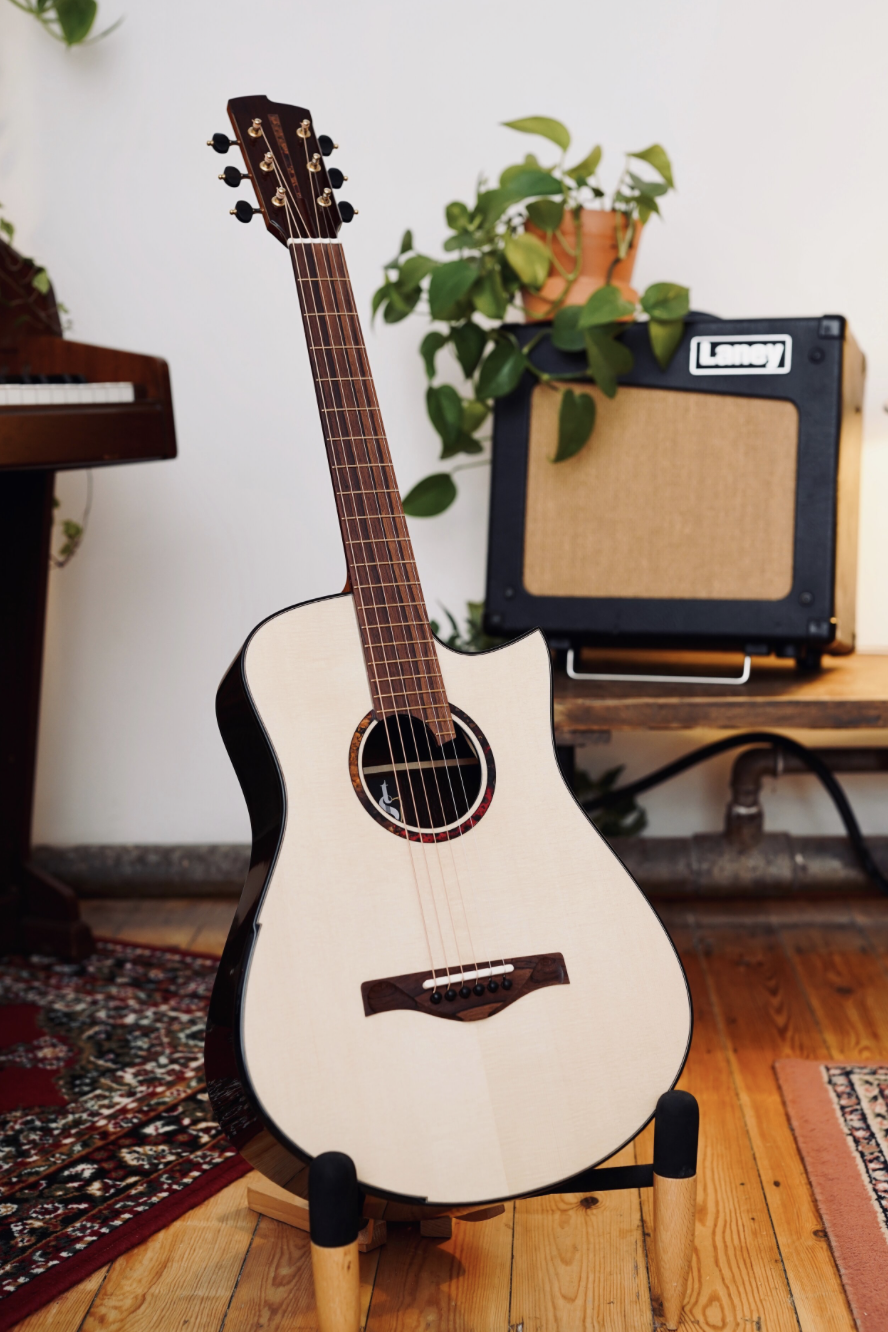Jordan joins the alumni with his brand new Model S!
All words courtesy of Jordan, the latest member of the TSG alumni.
“The guitar is a tiny powerhouse”
I have been a dreadnought player my whole life and in love with the deep, cavernous bass such guitars provide. But after turning 50, I decided for ergonomic reasons—and a touch of midlife crisis— that I wanted a smaller guitar. My friend Eric, my authority on all things lutherie, recommended I consider a Sands Model S guitar on the theory that commissioning from an apprentice of Ervin Somogyi would be the safest bet to get the fullest sound from a tiny instrument. I own a modified dreadnaught from another Somogyi apprentice and it’s out of this world. Tom’s is the first guitar I’ve ever purchased or commissioned without trying out any of the luthier’s instruments. It was a leap of faith to commit with Tom, but I was so blown away by his design ethos, and life is short, so I decided to go for it.
“...Tom’s is the first guitar I’ve ever purchased or commissioned without trying out any of the luthier’s instruments. It was a leap of faith to commit with Tom, but I was so blown away by his design ethos, and life is short, so I decided to go for it...”
The smaller body, shorter scale length of 24 ¾” and 12-fret join to the body—all standard to Tom’s Model S—assured me that the guitar would be cozy. Tom suggested a mini-bevel as well. During the build process, I was most concerned that the neck depth accommodate my hand with the least strain, so Tom had me take photos of the guitar necks I liked playing the most and instructed me to use a ruler to cast a shadow on the curvature so he could assess them. It was a simple low-tech solution, and the neck he ultimately carved is just as comfortable as my favorite necks, if not more so.
I deferred to Tom on all the tonal choices for the guitar beyond stipulating I wanted spruce for the top and either rosewood or blackwood for the back and sides. Tom recommended Italian spruce and Madagascar rosewood. He selected a rosewood set for the back and sides that, he said, while it was not flashily figured, had one of the best tap tones he had come across. In retrospect I’m glad that I left these choices up to him and didn’t try to play armchair luthier. The wood grain and color are subtle and beautiful, and the tone is fantastic.
“...since I’ve gotten the guitar, I’ve come to further appreciate some of the tiny aesthetic choices Tom made and his incredible attention to detail...”
I was more involved on the aesthetics. Deliberating on the appointments was the most fun part of the build. I’m particularly happy with our choice of Madagascar rosewood for the bridge, fretboard and headcap, all of which Tom fashioned out of the same billet. It adds so much character to the guitar. Though I was tempted to go all in with Madagascar rosewood for the binding as well, I decided that Tom’s standard Rocklite Ebano binding—made from composite hardwood— would provide a contrast to frame and accentuate the other woods, and also reverberate visually with the Robson ebony tuners.
Tom’s use of copper is the most distinctive element of his design, and it was hard to choose between etched and patinated copper. I chose Tom’s red, brown and gold “wildfire” patinated copper for the rosette, headstock inlay and end graft. Besides being striking on their own, they also pull out some of those colors in the rosewood. Tom refers to this particular copper palette as lava; I think they look like little framed photographs of cosmic gasses in a swirling nebulous cloud in space.
“...It has a rapid response and will creep along quietly and then take off fast and loud with plenty of headroom...”
Throughout 2020, checking in on what was going on in Tom’s shop through his astute use of social media and his website was a welcome distraction from the tumultuous politics of the US. I enjoyed his “The Week This Week” YouTube updates on the status of various projects; his video introductions of finished guitars; and the podcasts and shop sessions. Having plowed through Somogyi’s two dense volumes on lutherie without grasping much of the physics, it was a less intimidating experience to watch Tom’s funboxing videos in which he opens a newly arrived tool or shipment of wood. Of course, Tom also sent photos of my build along the way.
Since I’ve gotten the guitar, I’ve come to further appreciate some of the tiny aesthetic choices Tom made and his incredible attention to detail. The headstock is beveled on the sides with a simple purfling that you can see from the front. The headstock shape—which is a luthier’s distinctive signature in the Spanish luthier tradition that Somogyi embraced—is asymmetrical without being showy, and the fingerboard extension angle echoes it. The fretboard side position markers are flawlessly inserted tiny copper rings surrounding red dyed poplar dots, and Tom even put one in the teensy twenty-first fret that hangs over the soundhole. All his touches are elegant and restrained, making the guitar a piece of art I can play or just admire, or do both concurrently.
The guitar is a tiny powerhouse. It has a rapid response and will creep along quietly and then take off fast and loud with plenty of headroom. Its bass is full and piano-ish like a true Somogyi descendent. The tone, to use one of Tom’s favorite adjectives, is bonkers, and ultra-bonkers when tuned to open D or open G. Thanks to the magic of the web, you can listen to the guitar yourself.




